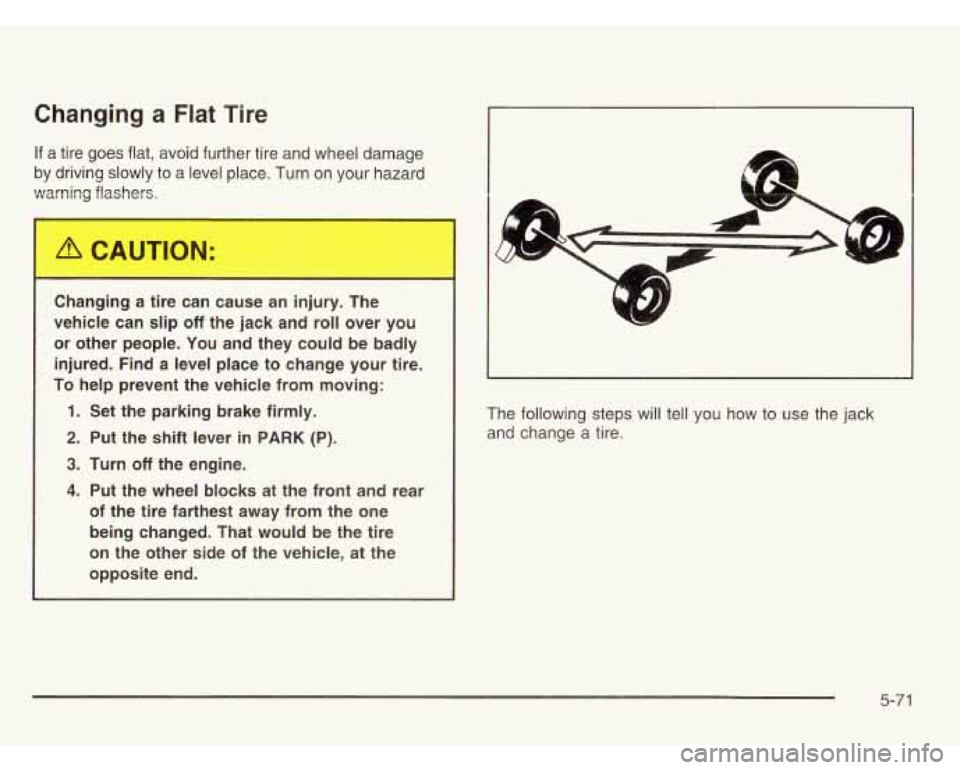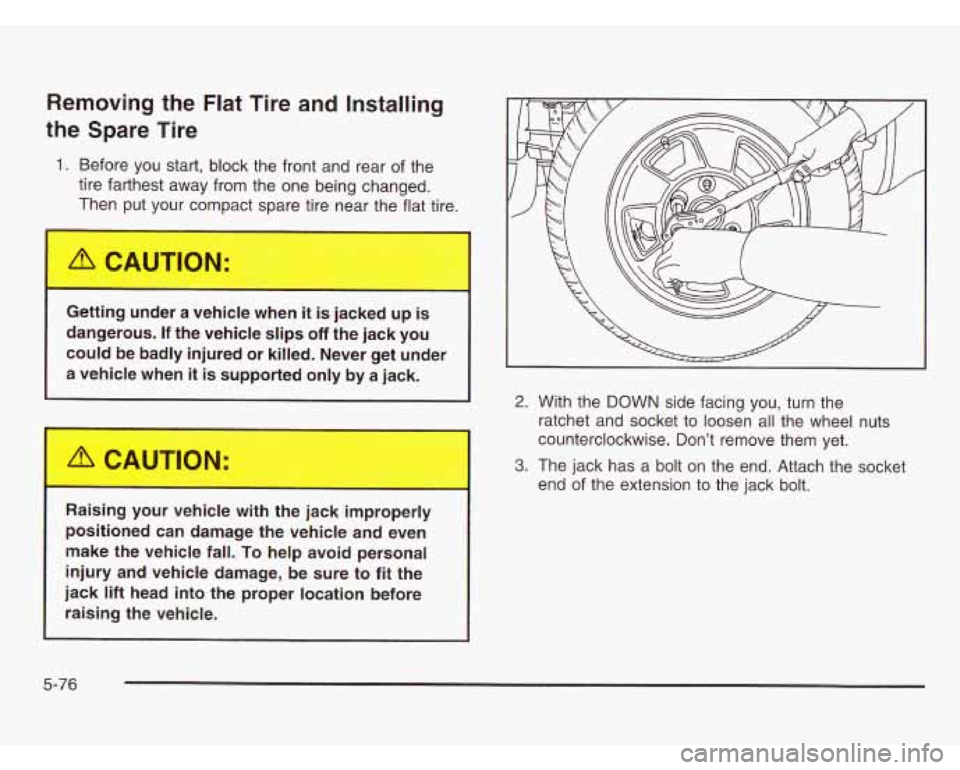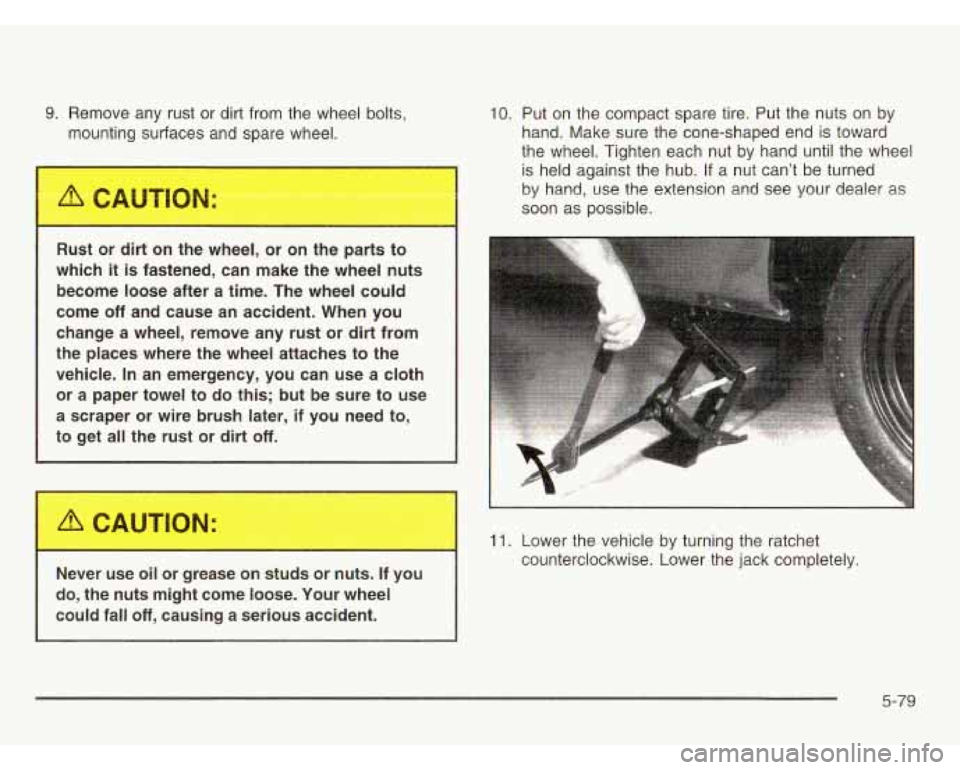2003 CHEVROLET ASTRO change wheel
[x] Cancel search: change wheelPage 288 of 386

Changing a Flat Tire
If a tire goes flat, avoid further tire and wheel damage
by driving slowly to a level place. Turn on your hazard
warning flashers.
Changing a tire can cause an injury. The
vehicle can slip
off the jack and roll over you
or other people. You and they could be badly
injured. Find a level place to change your tire.
To help prevent the vehicle from moving:
1. Set the parking brake firmly.
2. Put the shift lever in PARK (P).
3. Turn off the engine.
4. Put the wheel blocks at the front and rear
of the tire farthest away from the one
being changed. That would be the tire
on the other side of the vehicle, at the
opposite end. The following steps will tell
you how to
use the jack
and change a tire.
5-7 1
Page 293 of 386

Removing the Flat Tire and Installing
the Spare Tire
1. Before you start, block the front and rear of the
tire farthest away from the one being changed.
Then put your cor-xt spare tire near the flat tire.
I
Getting under a vehicle when it is jacked .I is
dangerous. If the vehicle slips off the jack you
could be badly injured or killed. Never get under
a vehicle when
it is supported only by a jack.
Ra.,.ng your vehicle
..ICIm Lhe jack improperly
positioned can damage the vehicle and even
make the vehicle fall.
To help avoid personal
injury and vehicle damage, be sure to fit the
jack
lift head into the proper location before
raising the vehicle.
2. With the DOWN side facing you, turn the
ratchet and socket to loosen all the wheel nuts
counterclockwise. Don’t remove them yet.
3. The jack has a bolt on the end. Attach the socket
end of the extension to the jack bolt.
5-76
Page 296 of 386

9. Remove any rust or dirt from the wheel bolts,
mounting surfaces and spare wheel.
Rust or dirt on
the wheel, or on the parts to
which
it is fastened, can make the wheel nuts
become loose after
a time. The wheel could
come
off and cause an accident. When you
change a wheel, remove any rust or
dirt from
the places where the wheel attaches to the
vehicle. In an emergency, you can use a cloth
or a paper towel to do this; but be sure to use
a scraper or wire brush later, if you need to,
to get all the rust
or dirt off.
10. Put on the compact spare tire. Put the nuts on by
hand. Make sure the cone-shaped end is toward
the wheel. Tighten each nut by hand until the wheel
is held against the hub.
If a nut can’t be turned
by hand, use the extension and see your dealer as
soon as possible.
Never use oil or grease on studs or nuts. If you
do, the nuts might come
loose. Your wheel
could fall
off, causing a serious accident.
-
11. Lower the vehicle by turning the ratchet
counterclockwise. Lower the jack completely.
5-79
Page 324 of 386

Selecting the Right Schedule
First you’ll need to decide which of the two schedules
is right for your vehicle. Here’s how to decide which
schedule to follow:
Short Trip/City Definition
Follow the Short Trip/City Scheduled Maintenance if any
one of these conditions is true for your vehicle:
e
e
e
e
Most trips are less than 5 miles (8 km). This is
particularly important when outside temperatures
are below freezing.
Most trips include extensive idling (such as frequent
driving in stop-and-go traffic).
You frequently tow a trailer or use a carrier on top
of your vehicle.
If the vehicle is used for delivery service, police,
taxi or other commercial application.
One of the reasons you should follow this schedule if
you operate your vehicle under any of these conditions
is that these conditions cause engine oil to break
down sooner.
Short Trip/City Intervals
Every 3,000 Miles (5 000 km): Engine Oil and Filter
Change (or
3 months, whichever occurs first). Chassis
Lubrication (or
3 months, whichever occurs first).
Drive Axle Fluid Check.
Every 6,000 Miles (IO 000 km): Tire Rotation.
Every 15,000 Miles (25 000 km): Engine Air
Cleaner Filter Inspection,
if driving in dusty conditions.
Front Wheel Bearing Repack (two-wheel drive only)
(or at each brake relining, whichever occurs first).
Automatic Transmission Service (severe conditions only).
Every 30,000 Miles (50 000 km): Engine Air Cleaner
Filter Replacement. Fuel Filter Replacement.
Every 50,000 Miles (83 000 km): Automatic
Transmission Service (normal conditions).
Transfer Case Fluid Change.
Every 100,000 Miles (166 000 km): Spark Plug Wire
Inspection. Spark Plug Replacement. Positive
Crankcase Ventilation (PCV) Valve Inspection.
Every 150,000 Miles (240 000 km): Cooling System
Service (or every
60 months, whichever occurs
first). Engine Accessory Drive Belt Inspection.
These intervals only summarize maintenance services.
Be sure to follow the complete scheduled maintenance
on the following pages.
6-5
Page 325 of 386

Long Trip/Highway Definition
Follow this scheduled maintenance only if none of
the conditions from the Short Trip/City Scheduled
Maintenance are true. Do not use this schedule
if the
vehicle is used for trailer towing, driven in a dusty area
or used
off paved roads. Use the Short Trip/City
schedule for these conditions.
Driving a vehicle with a fully warmed engine under
highway conditions will cause engine oil
to break
down slower.
Long Trip/Highway Intervals
Every 7,500 Miles (12 500 km): Engine Oil and Filter
Change (or every
12 months, whichever occurs first).
Chassis Lubrication (or
12 months, whichever
occurs first). Drive Axle Fluid Check. Tire Rotation.
Every 15,000 Miles (25 000 km): Automatic
Transmission Service (severe conditions only).
Every 30,000 Miles (50 000 km): Fuel Filter
Replacement. Engine Air Cleaner Filter Replacement.
Front Wheel Bearing Repack (two-wheel drive only)
(or at each brake relining, whichever occurs first).
Every 50,000 Miles (83 000 km): Automatic
Transmission Service (normal conditions).
Transfer Case Fluid Change.
Every 100,000 Miles (166 000 km): Spark Plug Wire
Inspection. Spark Plug Replacement. Positive
Crankcase Ventilation (PCV) Valve Inspection.
Every 150,000 Miles (240 000 km): Cooling System
Service (or every
60 months, whichever occurs first).
Engine Accessory Drive Belt Inspection.
These intervals only summarize maintenance services.
Be sure to follow the complete scheduled maintenance
on the following pages.
6-6
Page 327 of 386

12,000 Miles (20 000 km)
0 Change engine oil and filter (or every 3 months,
0 Lubricate chassis components (or every 3 months,
0 Check readfront axle fluid level and add fluid as
whichever
occurs first).
An Emission Control Service.
whichever occurs first). (See footnote #.)
needed. Check constant velocity joints and axle seals
for leaking.
page 5-64 for proper rotation pattern and additional
information.
(See footnote +.)
0 Rotate tires. See Tire lnspection and Rotation on
15,000 Miles (25 000 km)
0 Change engine oil and filter (or every 3 months,
whichever occurs first).
An Emission Control Service.
0 Lubricate chassis components (or every 3 months,
whichever occurs first).
(See footnote #.)
CI Inspect engine air cleaner filter if you are driving in
dusty conditions. Replace filter
if necessary.
An Emission Control Service. (See footnote t.)
0 Check readfront axle fluid level and add fluid as
needed. Check constant velocity joints and axle seals
for leaking.
0 For Two-Wheel-Drive vehicles only: Clean and repack
the front wheel bearings (or at each brake relining,
whichever occurs first).
0 Change automatic transmission fluid and filter if the
vehicle
is mainly driven under one or more of these
conditions:
- In heavy city traffic where the outside
temperature regularly reaches
90°F (32°C)
or higher.
- In hilly or mountainous terrain.
- When doing frequent trailer towing.
- Uses such as found in taxi, police or delivery
service.
If you do not use your vehicle under any of these
conditions, change the fluid and filter every
50,000 miles (83 000 km).
18,000 Miles (30 000 km)
0 Change engine oil and filter (or every 3 months,
whichever occurs first).
An Emission Control Service.
0 Lubricate chassis components (or every 3 months,
0 Check readfront axle fluid level and add fluid as
whichever
occurs first).(See
footnote #.)
needed. Check constant velocity joints and axle seals
for leaking.
0 Rotate tires. See Tire lnspection and Rotation on
page
5-64 for proper rotation pattern and additional
information.
(See footnote +.)
6-8
Page 328 of 386

21,000 Miles (35 000 km) 7,000 Miles (45 000 km)
B Change engine oil and filter (or every 3 months, 0 Change engine oil and filter (or every 3 months,
d Lubricate chassis components (or every 3 months, U Lubricate chassis components (or every 3 months,
whichever
occurs first).
An Emission Control Service. whichever occurs first). An Emission Control Service.
whichever occurs first). (See footnote #.) whichever occurs first). (See footnote #.) ,I
U Check readfront axle fluid level and add fluid as B Check readfront axle fluid level and add fluid as
needed. Check constant velocity joints and axle seals
for leaking.
needed. Check constant
velocity joints and axle seals
for leaking.
30,000 Miles (50 000 km)
24,000 Miles (40 000 km) 0 Change enqine oil and filter (or every 3 months,
u
Change engine oil and filter (or every 3 months,
whichever &curs first). An Emission- Control Service.
Lubricate chassis components (or every 3 months, whichever
occurs first). (See footnote #.)
whichever OCCUrS first). An Emission Control Service. 0 Lubricate chassis components (or every 3 months,
whichever occurs first):
(See footnote #.)
Check readfront axle fluid level and add fluid as
needed. Check constant velocity joints and axle seals
for leaking.
Rotate tires. See
Tire Inspection and Rotation on
page 5-64 for proper rotation pattern and additional
information.
(See footnote +.)
0 Check readfront axle fluid level and add fluid as
needed. Check constant velocity joints and axle seals
for leaking.
0 For Two-Wheel-Drive vehicles only: Clean and repack
the front wheel bearings (or at each brake relining,
whichever occurs first).
(See footnote t.)
0 Replace fuel filter. An Emission Control Service.
B Replace engine air cleaner filter. An Emission Control
Service.
6-9
Page 330 of 386

42,000 Miles (70 000 km)
CI Change engine oil and filter (or every 3 months,
whichever occurs first).
An Emission Control Service.
U Lubricate chassis components (or every 3 months,
whichever occurs first).
(See footnote #.)
c1 Check readfront axle fluid level and add fluid as
needed. Check constant velocity joints and axle seals
for leaking.
page 5-64 for proper rotation pattern and additional
information.
(See footnote +.)
0 Rotate tires. See Tire Inspection and Rotation on
45,000 Miles (75 000 km)
0 Change engine oil and filter (or every 3 months,
whichever occurs first).
An Emission Control Service.
Cl Lubricate chassis components (or every 3 months,
whichever occurs first).
(See footnote #.)
Cl Check readfront axle fluid level and add fluid as
needed. Check constant velocity joints and axle seals
for leaking.
CI For Two-Wheel-Drive vehicles only: Clean and repack
the front wheel bearings (or at each brake relining,
whichever occurs first).
U Change automatic transmission fluid and filter if the
vehicle is mainly driven under one or more of these
conditions:
- In heavy city traffic where the outside
temperature regularly reaches
90°F (32°C)
or higher.
- In hilly or mountainous terrain.
- When doing frequent trailer towing.
- Uses such as found in taxi, police or delivery
service.
U Inspect engine air cleaner filter if you are driving
in dusty conditions. Replace filter
if necessary.
An Emission Control Service. (See footnote t.)
If you do not use your vehicle under any of these
conditions, change the fluid and filter every
50,000 miles (83 000 km).
6-1 1